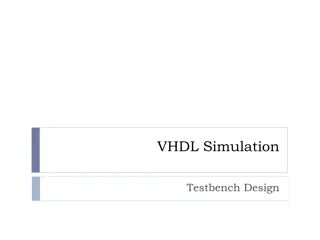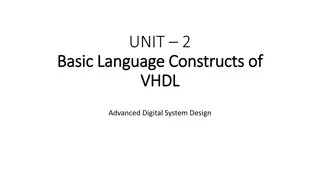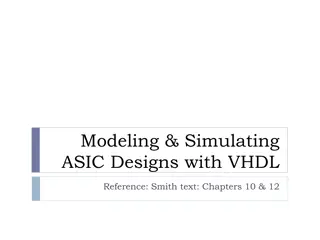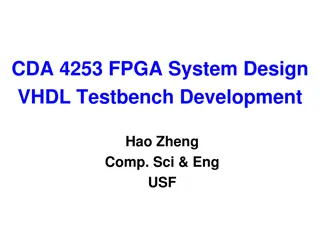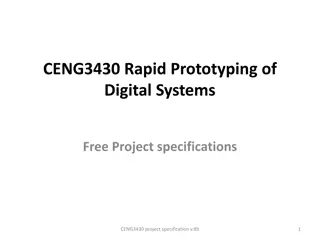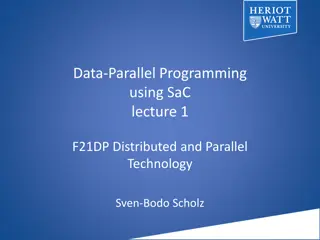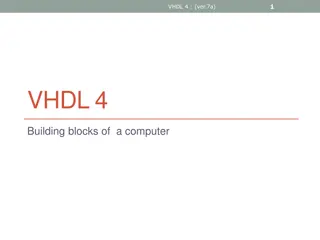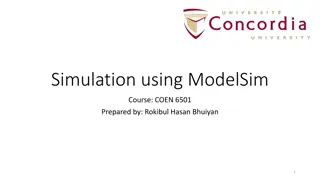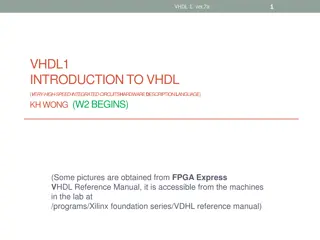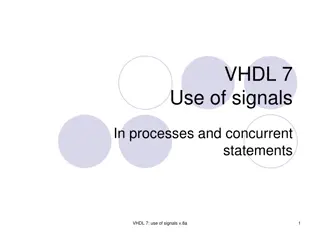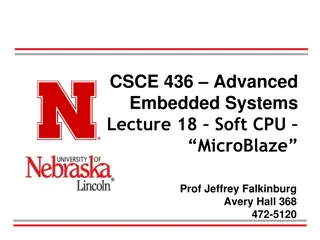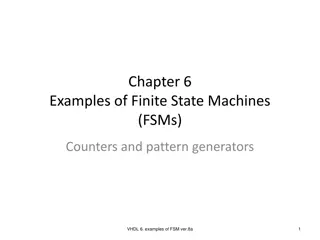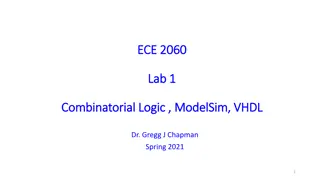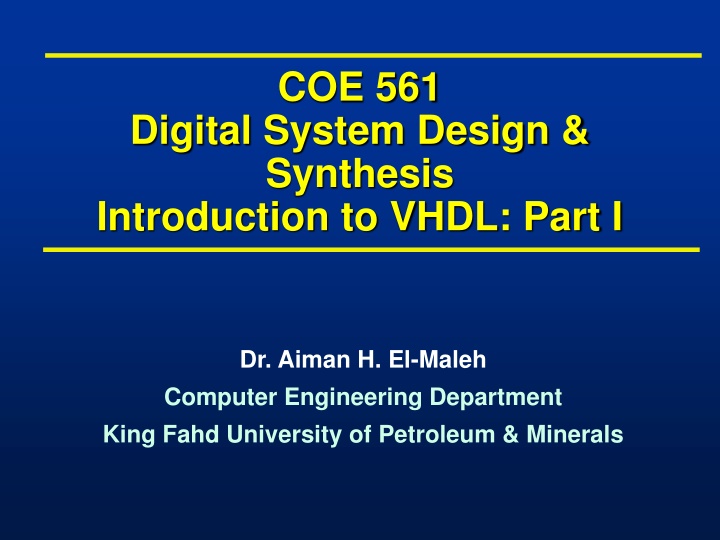
Introduction to VHDL: Digital System Design & Synthesis Overview
Explore the fundamentals of VHDL for digital system design and synthesis. Learn about hardware description languages, VHDL modeling, behavioral, dataflow, and structural styles, key terms like entities, ports, architecture, and configurations. Dive into examples and applications in computer engineering.
Download Presentation

Please find below an Image/Link to download the presentation.
The content on the website is provided AS IS for your information and personal use only. It may not be sold, licensed, or shared on other websites without obtaining consent from the author. If you encounter any issues during the download, it is possible that the publisher has removed the file from their server.
You are allowed to download the files provided on this website for personal or commercial use, subject to the condition that they are used lawfully. All files are the property of their respective owners.
The content on the website is provided AS IS for your information and personal use only. It may not be sold, licensed, or shared on other websites without obtaining consent from the author.
E N D
Presentation Transcript
COE 561 Digital System Design & Synthesis Introduction to VHDL: Part I Dr. Aiman H. El-Maleh Computer Engineering Department King Fahd University of Petroleum & Minerals
Outline Hardware description languages VHDL terms Design Entity Design Architecture VHDL model of full adder circuit VHDL model of 1 s count circuit Structural modeling of 4-bit comparator Design parameterization using Generic Test Bench example 2
Outline Signal assignment VHDL Objects Behavioral modeling in VHDL 3
Hardware Description Languages HDLs are used to describe the hardware for the purpose of modeling, simulation, testing, design, and documentation. Modeling: behavior, flow of data, structure Simulation: verification and test Design: synthesis Two widely-used HDLs today VHDL: VHSIC (Very High Speed Integrated Circuit ) Hardware Description Language Verilog (from Cadence, now IEEE standard) 4
Styles in VHDL Behavioral High level, algorithmic, sequential execution Hard to synthesize well Easy to write and understand (like high-level language code) Dataflow Medium level, register-to-register transfers, concurrent execution Easy to synthesize well Harder to write and understand (like assembly code) Structural Low level, netlist, component instantiations and wiring Trivial to synthesize Hardest to write and understand (very detailed and low level) 5
VHDL Terms Entity: All designs are expressed in terms of entities Basic building block in a design Ports: Provide the mechanism for a device to communication with its environment Define the names, types, directions, and possible default values for the signals in a component's interface Architecture: All entities have an architectural description Describes the behavior of the entity A single entity can have multiple architectures (behavioral, structural, etc) Configuration: A configuration statement is used to bind a component instance to an entity-architecture pair. Describes which behavior to use for each entity 6
VHDL Terms Generic: A parameter that passes information to an entity Example: for a gate-level model with rise and fall delay, values for the rise and fall delays passed as generics Process: Basic unit of execution in VHDL All operations in a VHDL description are broken into single or multiple processes Statements inside a process are processed sequentially Package: A collection of common declarations, constants, and/or subprograms to entities and architectures. 7
VHDL Terms Attribute: Data attached to VHDL objects or predefined data about VHDL objects Examples: maximum operation temperature of a device Current drive capability of a buffer VHDL is NOT Case-Sensitive Begin = begin = beGiN Semicolon ; terminates declarations or statements. After a double minus sign (--) the rest of the line is treated as a comment 8
VHDL Models ENTITY (interface description) PACKAGE DECLARATION PACKAGE BODY ARCHITECTURE (functionality) (often used functions, constants, components, . ) CONFIGURATION (connection entity architecture) 10
Design Entity In VHDL, the name of the system is the same as the name of its entity. Entity comprises two parts: parameters of the system as seen from outside such as bus- width of a processor or max clock frequency connections which are transferring information to and from the system (system s inputs and outputs) All parameters are declared as generics and are passed on to the body of the system Connections, which carry data to and from the system, are called ports. They form the second part of the entity. 11
Entity Examples Entity FULLADDER is -- Interface description of FULLADDER port ( A, B, C: in bit; SUM, CARRY: out bit); end FULLADDER; A B C SUM FULL ADDER CARRY 12
Entity Examples Entity Register is -- parameter: width of the register generic (width: integer); --input and output signals port ( CLK, Reset: in bit; D: in bit_vector(1 to width); Q: out bit_vector(1 to width)); end Register; width D width Q D Q CLK Reset 13
Architecture Examples: Behavioral Description Entity FULLADDER is port ( A, B, C: in bit; SUM, CARRY: out bit); end FULLADDER; Architecture CONCURRENT of FULLADDER is begin SUM <= A xor B xor C after 5 ns; CARRY <= (A and B) or (B and C) or (A and C) after 3 ns; end CONCURRENT; 14
Architecture Examples: Structural Description A SUM I1 S HA B S1 C2 I1 S I1 I2 C HA OR C1 C I2 x I2 C CARRY Entity HA is PORT (I1, I2 : in bit; S, C : out bit); end HA ; Architecture behavior of HA is begin S <= I1 xor I2; C <= I1 and I2; end behavior; OR is Entity PORT (I1, I2 : in bit; X : out bit); end OR ; Architecture behavior of OR is begin X <= I1 or I2; end behavior; 15
Architecture Examples: Structural Description architecture STRUCTURAL of FULLADDER is signal S1, C1, C2 : bit; component HA port (I1, I2 : in bit; S, C : out bit); end component; component OR port (I1, I2 : in bit; X : out bit); end component; begin INST_HA1 : HA port map (I1 => B, I2 => C, S => S1, C => C1); INST_HA2 : HA port map (I1 => A, I2 => S1, S => SUM, C => C2); INST_OR : OR port map ( C2, C1, CARRY); end STRUCTURAL; A SUM I1 S HA B S1 C2 I1 S I1 I2 C HA OR C1 C I2 x I2 C CARRY 16
VHDL Predefined Operators Logical Operators: NOT, AND, OR, NAND, NOR, XOR, XNOR Operand Type: Bit, Boolean, Bit_vector Result Type: Bit, Boolean, Bit_vector Relational Operators: =, /=, <, <=, >, >= Operand Type: Any type Result Type: Boolean Arithmetic Operators: +, -, *, / Operand Type: Integer, Real Result Type: Integer, Real Concatenation Operator: & Operand Type: Arrays or elements of same type Result Type: Arrays Shift Operators: SLL, SRL, SLA, SRA, ROL, ROR Operand Type: Bit or Boolean vector Result Type: same type 17
VHDL Reserved Words abs access after alias all and architecture array assert attribute begin block body buffer bus case component configuration constant disconnect downto linkage else elsif end entity exit new file for function generate generic guarded if in inout is label library package Poll procedure process units until use variable loop map mod nand rem next nor not null of on open or others out range record register while report return select severity signal subtype then to transport type wait when with xor 18
VHDL Language Grammar Formal grammar of the IEEE Standard 1076-1993 VHDL language in BNF format http://www.iis.ee.ethz.ch/~zimmi/download/vhdl93_syntax.html 19
One Entity Many Descriptions A system (an entity) can be specified with different architectures Entity Architecture A Architecture B Architecture C Architecture D 20
Example: Ones Count Circuit Value of C1 C0 = No. of ones in the inputs A2, A1, and A0 C1 is the Majority Function ( =1 iff two or more inputs =1) C0 is a 3-Bit Odd-Parity Function (OPAR3)) C1 = A1 A0 + A2 A0 + A2 A1 C0 = A2 A1 A0 + A2 A1 A0 + A2 A1 A0 + A2 A1 A0 = A0 A1 A2 A0 A1 C0 C1 A2 21
Ones Count Circuit Interface Specification 1 2 entity ONES_CNT is port ( A : in BIT_VECTOR(2 downto 0); C : out BIT_VECTOR(1 downto 0)); -- Function Documentation of ONES_CNT -- (Truth Table Form) -- ____________________ -- | A2 A1 A0 | C1 C0 | -- |-----------------|------------- | -- | 0 0 0 | 0 0 | -- | 0 0 1 | 0 1 | -- | 0 1 0 | 0 1 | -- | 0 1 1 | 1 0 | -- | 1 0 0 | 0 1 | -- | 1 0 1 | 1 0 | -- | 1 1 0 | 1 0 | -- | 1 1 1 | 1 1 | -- |__________ |________| end ONES_CNT; D O C U M E N T A T I O N 22 3
Ones Count Circuit Architectural Body: Data Flow C1 = A1 A0 + A2 A0 + A2 A1 C0 = A2 A1 A0 + A2 A1 A0 + A2 A1 A0 + A2 A1 A0 = A0 A1 A2 Architecture Dataflow of ONES_CNT is begin C(1) <=(A(1) and A(0)) or (A(2) and A(0)) or (A(2) and A(1)); C(0) <= (A(2) and not A(1) and not A(0)) or (not A(2) and A(1) and not A(0)) or (not A(2) and not A(1) and A(0)) or (A(2) and A(1) and A(0)); -- C(0) <= A(2) xor A(1) xor A(0); end Dataflow; 23
Ones Count Circuit Architectural Body: Structural C1 = A1 A0 + A2 A0 + A2 A1 = MAJ3(A) C0 = A2 A1 A0 + A2 A1 A0 + A2 A1 A0 + A2 A1 A0 = OPAR3(A) Structural Design Hierarchy ONES_CNT C0 C1 Majority Fun Odd-Parity Fun AND2 OR3 NAND3 NAND4 INV 24
Ones Count Circuit Architectural Body: Structural Entity MAJ3 is PORT( X: in BIT_Vector(2 downto 0); Z: out BIT); end MAJ3; Entity OPAR3 is PORT( X: in BIT_Vector(2 downto 0); Z: out BIT); end OPAR3; 25
VHDL Structural Description of Majority Function G1 Maj3 Majority Function x(0) x(1) A1 G4 G2 x(0) x(2) A2 Z A3 G3 x(1) x(2) Architecture Structural of MAJ3 is Component AND2 PORT( I1, I2: in BIT; O: out BIT); end Component ; Declare Components To be Instantiated Component OR3 PORT( I1, I2, I3: in BIT; O: out BIT); end Component ; 26
VHDL Structural Description of Majority Function SIGNAL A1, A2, A3: BIT; Declare Maj3 Local Signals begin -- Instantiate Gates g1: AND2 PORT MAP (X(0), X(1), A1); g2: AND2 PORT MAP (X(0), X(2), A2); g3: AND2 PORT MAP (X(1), X(2), A3); g4: OR3 PORT MAP (A1, A2, A3, Z); end Structural; Wiring of Maj3 Components 27
VHDL Structural Description of Odd Parity Function Architecture Structural of OPAR3 is g1 g2 Component INV x(0) A0B x(1) A1B g3 PORT( Ipt: in BIT; Opt: out BIT); x(2) A2B X(2) g4 A1B A0B end Component ; Z1 X(0) Component NAND3 Z2 g5 A1B A2B g8 Z PORT( I1, I2, I3: in BIT; Z3 X(0) g6 X(1) X(2) C0 Odd-Parity Z4 O: out BIT); X(1) g7 A2B (OPAR3) A0B end Component ; Component NAND4 PORT( I1, I2, I3, I4: in BIT; O: out BIT); end Component ; 28
VHDL Structural Description of Odd Parity Function SIGNAL A0B, A1B, A2B, Z1, Z2, Z3, Z4: BIT; begin g1: INV PORT MAP (X(0), A0B); g2: INV PORT MAP (X(1), A1B); g3: INV PORT MAP (X(2), A2B); g4: NAND3 PORT MAP (X(2), A1B, A0B, Z1); g5: NAND3 PORT MAP (X(0), A1B, A2B, Z2); g6: NAND3 PORT MAP (X(0), X(1), X(2), Z3); g7: NAND3 PORT MAP (X(1), A2B, A0B, Z4); g8: NAND4 PORT MAP (Z1, Z2, Z3, Z4, Z); end Structural; 29
VHDL Top Structural Level of Ones Count Circuit Architecture Structural of ONES_CNT is Component MAJ3 PORT( X: in BIT_Vector(2 downto 0); Z: out BIT); END Component ; Component OPAR3 PORT( X: in BIT_Vector(2 downto 0); Z: out BIT); END Component ; begin -- Instantiate Components c1: MAJ3 PORT MAP (A, C(1)); c2: OPAR3 PORT MAP (A, C(0)); end Structural; 30
VHDL Behavioral Definition of Lower Level Components Entity NAND2 is PORT( I1, I2: in BIT; O: out BIT); end NAND2; Architecture behavior of NAND2 is begin O <= not (I1 and I2); end behavior; Entity INV is PORT( Ipt: in BIT; Opt: out BIT); end INV; Architecture behavior of INV is begin Opt <= not Ipt; end behavior; Other Lower Level Gates Are Defined Similarly 31
A Cascadable Single-Bit Comparator When a > b the a_gt_b becomes 1 When a < b the a_lt_b becomes 1 If a = b outputs become the same as corresponding inputs 33
Structural Single-Bit Comparator Design uses basic components The less-than and greater-than outputs use the same logic 34
Structural Model of Single-Bit Comparator ENTITY bit_comparator IS PORT (a, b, gt, eq, lt : IN BIT; a_gt_b, a_eq_b, a_lt_b : OUT BIT); END bit_comparator; ARCHITECTURE gate_level OF bit_comparator IS -- COMPONENT n1 PORT (i1: IN BIT; o1: OUT BIT); END COMPONENT ; COMPONENT n2 PORT (i1, i2: IN BIT; o1:OUT BIT); END COMPONENT; COMPONENT n3 PORT (i1, i2, i3: IN BIT; o1: OUT BIT); END COMPONENT; -- Component Configuration FOR ALL : n1 USE ENTITY WORK.inv (single_delay); FOR ALL : n2 USE ENTITY WORK.nand2 (single_delay); FOR ALL : n3 USE ENTITY WORK.nand3 (single_delay); --Intermediate signals SIGNAL im1,im2, im3, im4, im5, im6, im7, im8, im9, im10 : BIT; 35
Structural Model of Single-Bit Comparator BEGIN -- a_gt_b output g0 : n1 PORT MAP (a, im1); g1 : n1 PORT MAP (b, im2); g2 : n2 PORT MAP (a, im2, im3); g3 : n2 PORT MAP (a, gt, im4); g4 : n2 PORT MAP (im2, gt, im5); g5 : n3 PORT MAP (im3, im4, im5, a_gt_b); -- a_eq_b output g6 : n3 PORT MAP (im1, im2, eq, im6); g7 : n3 PORT MAP (a, b, eq, im7); g8 : n2 PORT MAP (im6, im7, a_eq_b); -- a_lt_b output g9 : n2 PORT MAP (im1, b, im8); g10 : n2 PORT MAP (im1, lt, im9); g11 : n2 PORT MAP (b, lt, im10); g12 : n3 PORT MAP (im8, im9, im10, a_lt_b); END gate_level; 36
Netlist Description of Single-Bit Comparator ARCHITECTURE netlist OF bit_comparator IS SIGNAL im1,im2, im3, im4, im5, im6, im7, im8, im9, im10 : BIT; BEGIN -- a_gt_b output g0 : ENTITY Work.inv(single_delay) PORT MAP (a, im1); g1 : ENTITY Work.inv(single_delay) PORT MAP (b, im2); g2 : ENTITY Work.nand2(single_delay) PORT MAP (a, im2, im3); g3 : ENTITY Work.nand2(single_delay) PORT MAP (a, gt, im4); g4 : ENTITY Work.nand2(single_delay) PORT MAP (im2, gt, im5); g5 : ENTITY Work.nand3(single_delay) PORT MAP (im3, im4, im5, a_gt_b); -- a_eq_b output g6 : ENTITY Work.nand3(single_delay) PORT MAP (im1, im2, eq, im6); g7 : ENTITY Work.nand3(single_delay) PORT MAP (a, b, eq, im7); g8 : ENTITY Work.nand2(single_delay) PORT MAP (im6, im7, a_eq_b); -- a_lt_b output g9 : ENTITY Work.nand2(single_delay) PORT MAP (im1, b, im8); g10 : ENTITY Work.nand2(single_delay) PORT MAP (im1, lt, im9); g11 : ENTITY Work.nand2(single_delay) PORT MAP (b, lt, im10); g12 : ENTITY Work.nand3(single_delay) PORT MAP (im8, im9, im10, a_lt_b); END netlist; 37
4-Bit Comparator Iterative Structural Wiring: For . Generate Statement... ENTITY nibble_comparator IS PORT (a, b : IN BIT_VECTOR (3 DOWNTO 0); -- a and b data inputs gt, eq, lt : IN BIT; -- previous greater, equal & less than a_gt_b, a_eq_b, a_lt_b : OUT BIT); -- a > b, a = b, a < b END nibble_comparator; -- ARCHITECTURE iterative OF nibble_comparator IS COMPONENT comp1 PORT (a, b, gt, eq, lt : IN BIT; a_gt_b, a_eq_b, a_lt_b : OUT BIT); END COMPONENT; FOR ALL : comp1 USE ENTITY WORK.bit_comparator (gate_level); SIGNAL im : BIT_VECTOR ( 0 TO 8); BEGIN c0: comp1 PORT MAP (a(0), b(0), gt, eq, lt, im(0), im(1), im(2)); 38
4-Bit Comparator: For . Generate Statement c1to2: FOR i IN 1 TO 2 GENERATE c: comp1 PORT MAP ( a(i), b(i), im(i*3-3), im(i*3-2), im(i*3-1), im(i*3+0), im(i*3+1), im(i*3+2) ); END GENERATE; c3: comp1 PORT MAP (a(3), b(3), im(6), im(7), im(8), a_gt_b, a_eq_b, a_lt_b); END iterative; USE BIT_VECTOR for Ports a & b Separate first and last bit-slices from others Arrays FOR intermediate signals facilitate iterative wiring Can easily expand to an n-bit comparator 39
4-Bit Comparator: IF Generate Statement ARCHITECTURE iterative OF nibble_comparator IS -- COMPONENT comp1 PORT (a, b, gt, eq, lt : IN BIT; a_gt_b, a_eq_b, a_lt_b : OUT BIT); END COMPONENT; -- FOR ALL : comp1 USE ENTITY WORK.bit_comparator (gate_level); CONSTANT n : INTEGER := 4; SIGNAL im : BIT_VECTOR ( 0 TO (n-1)*3-1); -- BEGIN c_all : FOR i IN 0 TO n-1 GENERATE l : IF i = 0 GENERATE least: comp1 PORT MAP (a(i), b(i), gt, eq, lt, im(0), im(1), im(2) ); END GENERATE; 40
4-Bit Comparator: IF Generate Statement -- m : IF i = n-1 GENERATE most: comp1 PORT MAP (a(i), b(i), im(i*3-3), im(i*3-2), im(i*3-1), a_gt_b, a_eq_b, a_lt_b); END GENERATE; -- r : IF i > 0 AND i < n-1 GENERATE rest: comp1 PORT MAP (a(i), b(i), im(i*3-3), im(i*3-2), im(i*3-1), im(i*3+0), im(i*3+1), im(i*3+2) ); END GENERATE; -- END GENERATE; -- Outer Generate END iterative; 41
4-Bit Comparator: Alternative Architecture (Single Generate) ARCHITECTURE Alt_iterative OF nibble_comparator IS constant n: Positive :=4; COMPONENT comp1 PORT (a, b, gt, eq, lt : IN BIT; a_gt_b, a_eq_b, a_lt_b : OUT BIT); END COMPONENT; FOR ALL : comp1 USE ENTITY WORK.bit_comparator (gate_level); SIGNAL im : BIT_VECTOR ( 0 TO 3*n+2); BEGIN im(0 To 2) <= gt & eq & lt; cALL : FOR i IN 0 TO n-1 GENERATE c : comp1 PORT MAP (a(i), b(i), im(i*3), im(i*3+1), im(i*3+2), im(i*3+3), im(i*3+4), im(i*3+5) ); END GENERATE; a_gt_b <= im(3*n); a_eq_b <= im(3*n+1); a_lt_b <= im(3*n+2); END Alt_iterative ; 42
Design Parameterization GENERICs can pass design parameters GENERICs can include default values New versions of gate descriptions contain timing ENTITY inv_t IS GENERIC (tplh : TIME := 3 NS; tphl : TIME := 5 NS); PORT (i1 : in BIT; o1 : out BIT); END inv_t; -- ARCHITECTURE average_delay OF inv_t IS BEGIN o1 <= NOT i1 AFTER (tplh + tphl) / 2; END average_delay; 43
Design Parameterization ENTITY nand2_t IS GENERIC (tplh : TIME := 4 NS; tphl : TIME := 6 NS); PORT (i1, i2 : IN BIT; o1 : OUT BIT); END nand2_t; -- ARCHITECTURE average_delay OF nand2_t IS BEGIN o1 <= i1 NAND i2 AFTER (tplh + tphl) / 2; END average_delay; ENTITY nand3_t IS GENERIC (tplh : TIME := 5 NS; tphl : TIME := 7 NS); PORT (i1, i2, i3 : IN BIT; o1 : OUT BIT); END nand3_t; -- ARCHITECTURE average_delay OF nand3_t IS BEGIN o1 <= NOT ( i1 AND i2 AND i3 ) AFTER (tplh + tphl) / 2; END average_delay; 44
Using Default values ARCHITECTURE default_delay OF bit_comparator IS Component n1 PORT (i1: IN BIT; o1: OUT BIT); END Component; Component n2 PORT (i1, i2: IN BIT; o1: OUT BIT); END Component; Component n3 PORT (i1, i2, i3: IN BIT; o1: OUT BIT); END Component; FOR ALL : n1 USE ENTITY WORK.inv_t (average_delay); FOR ALL : n2 USE ENTITY WORK.nand2_t (average_delay); FOR ALL : n3 USE ENTITY WORK.nand3_t (average_delay); -- Intermediate signals SIGNAL im1,im2, im3, im4, im5, im6, im7, im8, im9, im10 : BIT; BEGIN -- a_gt_b output g0 : n1 PORT MAP (a, im1); g1 : n1 PORT MAP (b, im2); g2 : n2 PORT MAP (a, im2, im3); g3 : n2 PORT MAP (a, gt, im4); g4 : n2 PORT MAP (im2, gt, im5); g5 : n3 PORT MAP (im3, im4, im5, a_gt_b); No Generics Specified in Component Declarations 45
Using Default values -- a_eq_b output g6 : n3 PORT MAP (im1, im2, eq, im6); g7 : n3 PORT MAP (a, b, eq, im7); g8 : n2 PORT MAP (im6, im7, a_eq_b); -- a_lt_b output g9 : n2 PORT MAP (im1, b, im8); g10 : n2 PORT MAP (im1, lt, im9); g11 : n2 PORT MAP (b, lt, im10); g12 : n3 PORT MAP (im8, im9, im10, a_lt_b); END default_delay; Component declarations do not contain GENERICs Component instantiation are as before If default values exist, they are used 46
Assigning Fixed Values to Generic Parameters ARCHITECTURE fixed_delay OF bit_comparator IS Component n1 Generic (tplh, tphl : Time); Port (i1: in Bit; o1: out Bit); END Component; Component n2 Generic (tplh, tphl : Time); Port (i1, i2: in Bit; o1: out Bit); END Component; Component n3 Generic (tplh, tphl : Time); Port (i1, i2, i3: in Bit; o1: out Bit); END Component; FOR ALL : n1 USE ENTITY WORK.inv_t (average_delay); FOR ALL : n2 USE ENTITY WORK.nand2_t (average_delay); FOR ALL : n3 USE ENTITY WORK.nand3_t (average_delay); -- Intermediate signals SIGNAL im1,im2, im3, im4, im5, im6, im7, im8, im9, im10 : BIT; BEGIN -- a_gt_b output g0 : n1 Generic Map (2 NS, 4 NS) Port Map (a, im1); g1 : n1 Generic Map (2 NS, 4 NS) Port Map (b, im2); g2 : n2 Generic Map (3 NS, 5 NS) Port Map (a, im2, im3); 47
Assigning Fixed Values to Generic Parameters g3 : n2 Generic Map (3 NS, 5 NS) Port Map P (a, gt, im4); g4 : n2 Generic Map (3 NS, 5 NS) Port Map (im2, gt, im5); g5 : n3 Generic Map (4 NS, 6 NS) Port Map (im3, im4, im5, a_gt_b); -- a_eq_b output g6 : n3 Generic Map (4 NS, 6 NS) Port Map (im1, im2, eq, im6); g7 : n3 Generic Map (4 NS, 6 NS) PORT MAP (a, b, eq, im7); g8 : n2 Generic Map (3 NS, 5 NS) PORT MAP (im6, im7, a_eq_b); -- a_lt_b output g9 : n2 Generic Map (3 NS, 5 NS) Port Map (im1, b, im8); g10 : n2 Generic Map (3 NS, 5 NS) PORT MAP (im1, lt, im9); g11 : n2 Generic Map (3 NS, 5 NS) PORT MAP (b, lt, im10); g12 : n3 Generic Map (4 NS, 6 NS) PORT MAP (im8, im9, im10, a_lt_b); END fixed_delay; Component declarations contain GENERICs Component instantiation contain GENERIC Values GENERIC Values overwrite default values 48
Structural Test Bench A Testbench is an Entity without Ports that has a Structural Architecture The Testbench Architecture, in general, has 3 major components: Instance of the Entity Under Test (EUT) Test Pattern Generator ( Generates Test Inputs for the Input Ports of the EUT) Response Evaluator (Compares the EUT Output Signals to the Expected Correct Output) 49
Testbench Example Entity nibble_comparator_test_bench IS End nibble_comparator_test_bench ; -- ARCHITECTURE input_output OF nibble_comparator_test_bench IS -- COMPONENT comp4 PORT (a, b : IN bit_vector (3 DOWNTO 0); gt, eq, lt : IN BIT; a_gt_b, a_eq_b, a_lt_b : OUT BIT); END COMPONENT; -- FOR a1 : comp4 USE ENTITY WORK.nibble_comparator(iterative); -- SIGNAL a, b : BIT_VECTOR (3 DOWNTO 0); SIGNAL eql, lss, gtr, gnd : BIT; SIGNAL vdd : BIT := '1'; -- BEGIN a1: comp4 PORT MAP (a, b, gnd, vdd, gnd, gtr, eql, lss); -- 50



